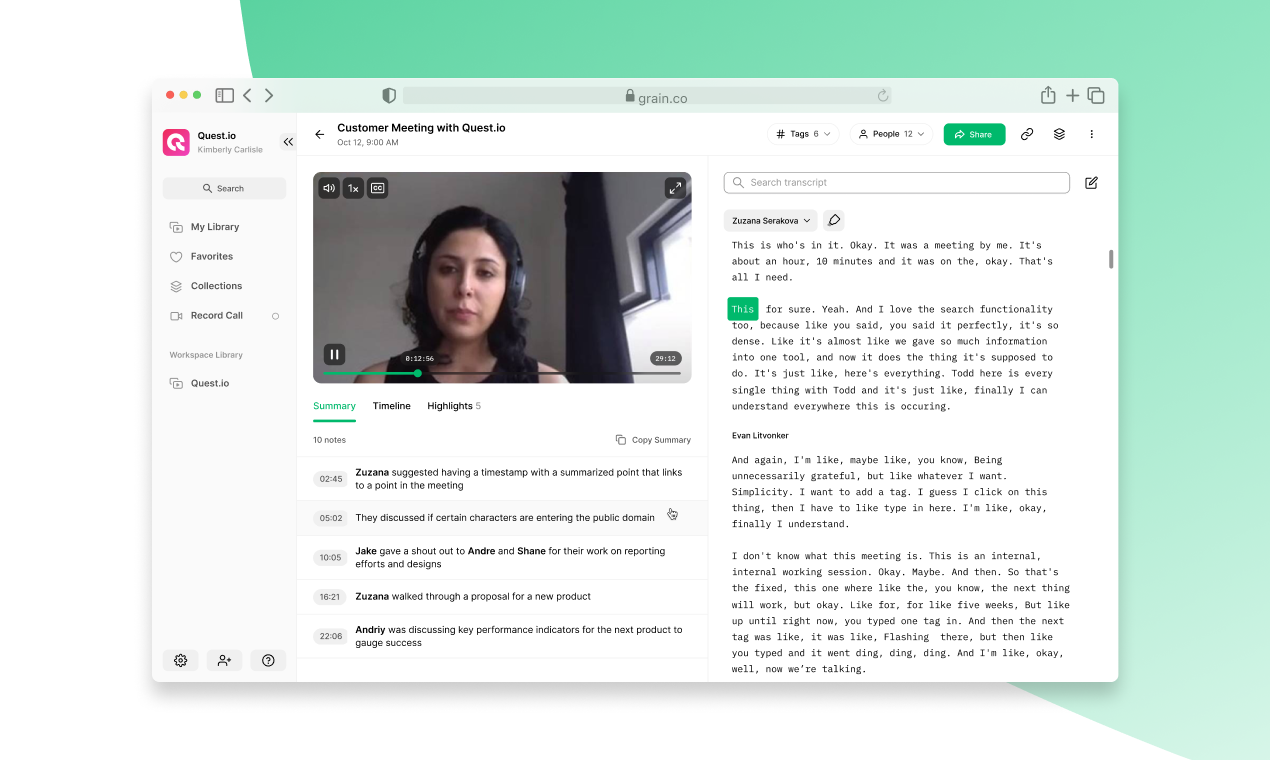Complete Guide to Transcribing Zoom for Your Workflow
Why You Should Transcribe Zoom Meetings
With the rise of remote work and virtual meetings, Zoom has become the go-to platform for professional and personal communications. However, keeping track of everything discussed in meetings can be challenging. Transcribing your Zoom meetings helps with this—converting spoken words into a meeting transcript helps you easily revisit key points, capture action items, and share summaries with those who couldn’t attend.
Transcribing Zoom meetings gives you a record of precisely what was said on a call that can be used for note-taking, documentation, and training. It’s also beneficial for accessibility, as it helps users who are hearing-impaired or speak different languages to follow along more effectively. Whether you want to transcribe a Zoom recording for personal review or need to transcribe a Zoom meeting into Word for detailed analysis, having a reliable transcription method is crucial.
In this guide, we’ll explore four different options to transcribe Zoom meetings, each with its unique benefits, limitations, and use cases. But first, we’ll share a few more benefits on why you might want to do this.
Benefits of Transcribing Zoom Meetings
Transcribing Zoom meetings offers numerous benefits for individuals and organizations. Here are some of the key advantages:
- Enhanced Productivity: With a written record of the meeting, participants can quickly review and reference key points, decisions, and action items. This saves time and boosts productivity by eliminating the need to recall details from memory.
- Better Collaboration: Transcripts provide a shared understanding of meeting discussions and outcomes, facilitating better collaboration among team members. Everyone stays on the same page, reducing the risk of miscommunication.
- Increased Accuracy: Having a written transcript reduces the risk of errors and misunderstandings. It ensures that all parties have an accurate record of what was discussed and agreed upon.
- Compliance and Record-Keeping: Transcripts serve as a permanent record of Zoom meetings, which can be invaluable for compliance, auditing, and record-keeping purposes. This is particularly important for industries with strict regulatory requirements.
- Improved Accessibility: Transcripts make Zoom meetings more accessible to people with hearing impairments, language barriers, or those who prefer to read rather than listen. This ensures that everyone can follow along and participate fully.
Understanding Zoom Transcription Options
Zoom provides several methods for transcribing meetings, either through its built-in features or by using third-party tools like Grain for more advanced functionalities. Your choice of method will depend on your needs—whether it’s live transcriptions, post-meeting transcription from recordings, or more advanced editing and sharing options. Users can access their recordings and transcriptions by signing into their account on the Zoom web portal. Here are four reliable options to consider:
Option #1: Using Zoom’s Closed Captions Feature
One of the easiest ways to transcribe a Zoom meeting is by using Zoom’s Closed Captions feature. This feature provides live captions during the meeting, making it accessible for participants who prefer reading along or need real-time text support. However, this method doesn’t create a permanent transcript that can be reviewed later—it’s purely for real-time use.
Pros:
- No Recording Required: Closed Captions are available without the need to record the meeting, which is helpful in scenarios where recording might not be preferred.
- Real-Time Accessibility: Participants can read the conversation in real-time, making it ideal for people with hearing impairments.
Cons:
- Limited Availability: This feature is only available for Zoom’s Pro, Business, or Enterprise plans.
- Accuracy Issues: Real-time transcriptions may not be as accurate, especially when dealing with technical terms, accents, or poor audio quality.
Best Use Case: Zoom’s Closed Captions are best suited for meetings where you need live transcription but don’t require a permanent record. It’s particularly useful for internal discussions and webinars focused on accessibility.
Option #2: Transcribing Using Zoom Local Recordings
If you need a permanent record of your Zoom meetings that you can transcribe later, using local recordings is a reliable option. Local recordings, including audio and video files, are saved directly to your computer, making them easy to access and transcribe using third-party services like Grain.
How to Use Zoom Local Recordings for Transcription:
- Enable Local Recording: Navigate to Zoom’s settings and enable local recording.
- Start Recording: During your Zoom meeting, click on the “Record” button and select “Record on this Computer.”
- Save the Recording: Once the meeting concludes, the recording will be saved to your device.
- Upload for Transcription: Use a service like Grain to transcribe the recording into a text document.
Pros:
- Offline Storage: Local recordings are saved on your computer, so you don’t need an internet connection to access them.
- Greater Control: Since the recordings are stored locally, you have full control over where to store and how to manage the files.
Cons:
- Requires Manual Upload: You’ll need to upload the recording manually to a transcription tool for conversion.
- Consent Issues: Recording requires the consent of all participants, which can sometimes complicate the process.
Best Use Case: This method is ideal for individuals or small teams who want to transcribe Zoom recordings for later review without relying on cloud storage.
Option #3: Using Zoom Cloud Recordings for Transcription
For a more streamlined approach, using Zoom’s Cloud Recording feature combined with a third-party tool like Grain can simplify the transcription process. With Zoom Cloud Recordings, your meetings are automatically saved in the cloud, making them accessible from any device.
Steps to Transcribe Zoom Cloud Recordings:
- Enable Cloud Recording: Go to your Zoom settings and enable Cloud Recording.
- Enable Audio Transcription: In the Zoom settings, ensure you enable audio transcription if your license supports it. This will allow you to access transcripts of your recordings.
- Record the Meeting: During your Zoom session, click “Record” and select “Record to the Cloud.”
- Connect with Grain: After the meeting, use Grain’s integration to import your Zoom Cloud Recording.
- Transcribe and Edit: Grain provides a rich text editor where you can review, edit, and export the transcription.
Pros:
- Automatic Upload: Recordings are automatically uploaded to the cloud, making them easily accessible without manual intervention.
- Seamless Integration: Integration with Grain or other transcription tools simplifies the process of converting speech to text.
Cons:
- Internet Dependency: Requires a stable internet connection to upload recordings to the cloud and access the files.
- Storage Limitations: Cloud storage is limited, and additional storage may incur extra costs.
Best Use Case: This method is best for businesses or teams that regularly record meetings and want a centralized storage solution for easy access and transcription.
Option #4: Transcribing Zoom Meetings Directly with Grain

Grain offers a comprehensive solution for transcribing Zoom meetings. It allows you to record, transcribe, and edit transcripts in one place. With Grain, you can highlight key points, create meeting summaries, and share specific segments with team members.
How to Transcribe Zoom Meetings with Grain:
- Sign Up for Grain: Create an account and follow the setup process here. It should only take a few clicks to get up and running!
- Start a Zoom Meeting: Use Grain’s recording feature to capture the meeting. You can learn more about how to do this here.
- Access Transcriptions: After the meeting, Grain will automatically generate a transcript and a meeting summary. Grain also has live transcriptions as well!
- Edit and Share: Use Grain’s tools to edit, highlight, or share meeting notes.
Best Use Case: Recommended for professionals or teams looking for advanced transcription and editing capabilities with seamless Zoom integration.
Comparison of Zoom Transcription Options
Here’s a quick overview to help you choose the best option based on your specific needs:
Zoom Closed Captions:
- Recording Required? No
- Real-Time Transcription? Yes
- Best For: Accessibility during live meetings without creating a permanent record.
Zoom Local Recordings:
- Recording Required? Yes
- Real-Time Transcription? No
- Best For: Offline storage and manual transcription.
Zoom Cloud Recording + Grain:
- Recording Required? Yes
- Real-Time Transcription? No
- Best For: Automatic storage and easy transcription access. Seamless Integration: Having an audio transcript is beneficial for reviewing meeting discussions, as it allows for easy reference and editing.
Grain Direct Transcription:
- Recording Required? Yes
- Real-Time Transcription? Yes
- Best For: Advanced transcription and editing with built-in collaboration tools and more.
Choosing the Best Transcription Method for Your Workflow
When choosing the best transcription method for your Zoom meetings, consider the following:
- Do You Need Real-Time Transcriptions? - If so, use Zoom’s Closed Captions feature for live captions, or Grain to get instant access to the transcript while the meeting is occurring.
- Need Cloud Storage and Seamless Integration? - Choose Zoom Cloud Recording combined with Grain for automatic uploads and transcriptions.
- Do You Require Advanced Editing and Sharing? - Grain is your best option if you need more powerful transcription management.
Best Practices for Zoom Meeting Transcription
To get the most out of Zoom meeting transcription, follow these best practices:
- Speak Clearly and Slowly: Encourage participants to speak clearly and at a moderate pace. This ensures that the transcription is accurate and easy to follow.
- Minimize Background Noise: Reduce background noise and distractions to improve audio quality. This can significantly enhance the accuracy of the transcription.
- Use a High-Quality Microphone: Invest in a good-quality microphone to ensure clear and crisp audio. This is especially important for capturing detailed discussions.
- Review and Edit Transcripts: After the meeting, review and edit the transcripts to ensure accuracy, completeness, and clarity. This step is crucial for creating a reliable record of the meeting.
- Store Transcripts Securely: Store transcripts securely and in compliance with relevant data protection regulations. This ensures that sensitive information is protected and accessible only to authorized personnel.
Security and Compliance Considerations for Zoom Meeting Transcription
When transcribing Zoom meetings, it’s essential to consider security and compliance implications. Here are some key considerations:
- Data Protection: Ensure that transcripts are stored and processed in compliance with relevant data protection regulations, such as GDPR or HIPAA. This protects the privacy and security of meeting participants.
- Access Control: Control access to transcripts and ensure that only authorized personnel can view or edit them. Implementing strict access controls helps prevent unauthorized access and data breaches.
- Encryption: Use encryption to protect transcripts during transmission and storage. This adds an extra layer of security, ensuring that sensitive information remains confidential.
- Compliance with Industry Regulations: Ensure that transcription practices comply with industry-specific regulations, such as FINRA or PCI-DSS. This is crucial for maintaining compliance and avoiding potential legal issues.
- Transcript Retention: Establish a clear policy for retaining and disposing of transcripts. Ensure that they are stored securely and in compliance with relevant regulations, and that they are disposed of properly when no longer needed.
By following these guidelines, you can ensure that your Zoom meeting transcriptions are accurate, secure, and compliant with all relevant regulations. You can learn more information about Grain's security and privacy measures here.
Final Thoughts: Making the Best Choice for Your Workflow
The best transcription option for Zoom meetings will depend on your unique needs. Whether it’s live transcription through Zoom’s Closed Captions or a more robust solution like Grain, choosing the right tool can help you manage your meeting content more effectively.
Get Started with Grain: Your Solution for Seamless Zoom Transcriptions
To experience the most advanced transcription capabilities, try Grain for free today and elevate your Zoom meeting experience!



.png)



